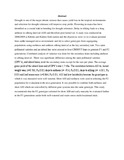Developing Drought Tolerant Maize Genotypes In Kenya: Selection For Anthesis To Silking Interval

View/
Date
2011Author
Cheserek, J.
Ngugi, E.C.K.
Chemining’wa, G.N.
Type
PresentationLanguage
enMetadata
Show full item recordAbstract
Drought is one of the major abiotic stresses that causes yield loss in the tropical environments
and selection for drought tolerance will improve crop yields. Flowering in maize has been
identified as a crucial trait in breeding for drought tolerance. Delay in silking leads to a long
anthesis to silking interval (ASI) and therefore poor kernel set. A study was conducted in
2008/2009 at Kiboko and Kabete field station and the objectives were: (i) to evaluate parental
lines under managed stress environment and (ii) to select genotypes from segregating
populations using earliness and anthesis silking interval as the key secondary trait. Two open
pollinated varieties and an inbred line were crossed to four CIMMYT lines to generate F1 and F2
generations. Combined analysis of variance was done for the secondary traits including anthesis
to silking interval . There was significant difference among the open pollinated varieties
(OPV’s), and inbred lines, in all the secondary traits except for the ears per plant. The average
grain yield of the inbred lines and of OPV’s was 1.7 t/ha. The correlation between ASI to; kernel
weight was, (r=0.763, P≤ 0.01) days to anthesis (r= -914, P≤ 0.01), days to silking (r= -0.811, P≤
0.05) and leaf senescence (r=0.864, P≤ 0.01). ASI had low heritability because the genotypes in
which it was measured were well watered. Short ASI and earliness were used in selecting the F2
population for evaluation in the next generation. It was possible to combine both earliness and
short ASI which are controlled by different gene systems into the same genotype. This study
recommends that the F2 genotypes selected for short ASI and early-maturity be evaluated further
in the F3 generations under both well-watered and water-stress multi-locational trials.
